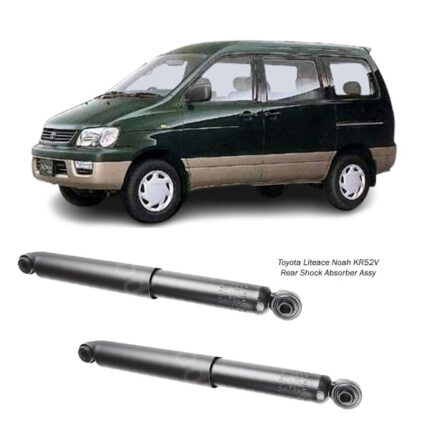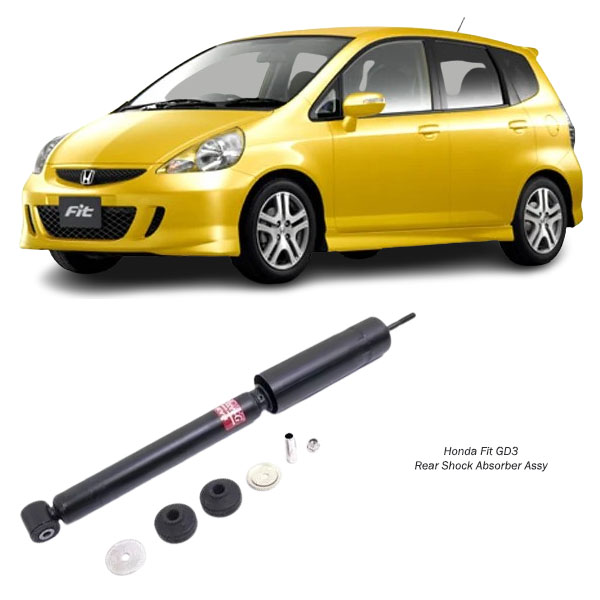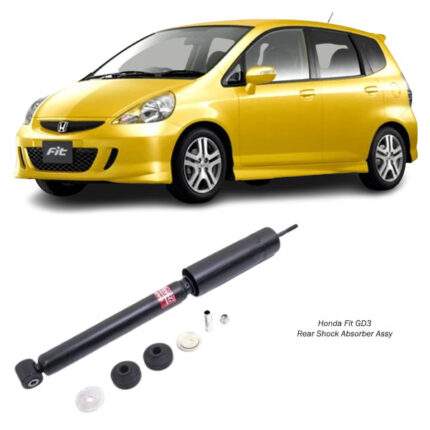Get Honda Fit GD Rear Shock Absorber Assy 343381 in Kenya
The Rear Shock Absorber Assembly is a crucial component of a vehicle’s suspension system, designed to absorb shocks, dampen vibrations, and provide a smooth ride. Whether you’re driving on a highway, rough terrain, or city streets, your shock absorbers play a key role in vehicle stability, comfort, and safety.
In this guide, we’ll cover what rear shock absorbers do, their components, types, symptoms of failure, replacement process, and maintenance tips. Understanding these aspects will help you keep your vehicle running smoothly and prevent costly repairs.
1. What is a Rear Shock Absorber Assembly?
A Rear Shock Absorber Assembly is part of the rear suspension system that controls movement between the wheels and the car’s body. It ensures the tires maintain contact with the road, improving handling and ride quality.
Main Functions of Rear Shock Absorbers:
Absorb road impacts and reduce vibrations
Maintain tire contact with the road for better traction
Improve vehicle stability and handling
Reduce wear on other suspension components
Enhance passenger comfort by minimizing jolts
Without properly functioning rear shock absorbers, your ride would be bumpy, unstable, and unsafe.
2. Components of a Rear Shock Absorber Assembly
A typical rear shock absorber assembly consists of several essential parts:
Shock Absorber (Damper) 🛞 – The main component that controls suspension movement by dampening vibrations.
Shock Mounts – Connect the shock absorber to the vehicle’s chassis and suspension.
Piston & Cylinder – The piston moves inside the cylinder filled with hydraulic fluid or gas to absorb shocks.
Coil Spring (in Struts) – Helps support vehicle weight and absorb larger shocks.
Bushings & Bearings – Reduce friction and allow smooth suspension movement.
Each component must be in good condition for smooth and safe driving.
3. Types of Rear Shock Absorbers
Shock absorbers come in different types based on design, material, and performance characteristics:
Hydraulic Shock Absorbers (Oil-Filled)
Most common type in standard vehicles
Uses hydraulic fluid to absorb shocks
Provides a smooth ride but may overheat with excessive use
Gas-Filled Shock Absorbers
Contains gas (nitrogen) and hydraulic oil to prevent foaming
More consistent performance in rough terrain or high speeds
Common in modern passenger cars and SUVs
Twin-Tube Shock Absorbers
Consists of two tubes—one for hydraulic fluid and another for pressure control
More affordable and widely used
Provides good comfort but less performance in extreme conditions
Mono-Tube Shock Absorbers
Has a single tube design for better heat dissipation
More durable and responsive than twin-tube shocks
Often used in sports and performance vehicles
Coil-Over Shock Absorbers
Includes a coil spring wrapped around the shock absorber
Found in high-performance or modified vehicles
Allows adjustable ride height and stiffness
Choosing the right type of shock absorber depends on your driving needs, road conditions, and vehicle type.
4. Signs of a Failing Rear Shock Absorber
Shock absorbers wear out over time, reducing their ability to absorb impacts effectively. Here are common signs of failure:
Excessive Bouncing – If your car bounces multiple times after hitting a bump, the shocks may be worn out.
Unstable Handling – Poor control during turns, braking, or acceleration.
Longer Braking Distance – Worn shocks reduce road contact, increasing stopping distance.
Uneven Tire Wear – Signs of “cupping” or scalloped wear patterns on tires.
Leaking Fluid – Visible oil leaks on the shock absorber indicate failure.
Clunking or Rattling Noises – Worn bushings or mounts may cause noise when driving over bumps.
Ignoring these warning signs can lead to reduced vehicle control, safety risks, and costly suspension damage.
5. How to Replace a Rear Shock Absorber Assembly
Replacing worn-out rear shock absorbers can restore ride quality and improve handling. Below is a step-by-step guide:
Tools Required:
Jack & Jack Stands
Lug Wrench
Socket & Ratchet Set
Torque Wrench
Penetrating Oil (for rusted bolts)
New Shock Absorbers
Step-by-Step Replacement Process:
Lift the Vehicle – Use a jack and jack stands to secure the car.
Remove the Wheel – Take off the rear wheel for better access.
Locate the Rear Shock Absorber – Identify the top and bottom mounting points.
Unbolt the Shock Absorber – Spray penetrating oil on rusted bolts if needed.
Remove the Old Shock Absorber – Carefully take it out.
Install the New Shock Absorber – Align it correctly and secure the bolts.
Tighten All Bolts – Use a torque wrench for proper tightness.
Reinstall the Wheel & Lower the Vehicle – Secure everything and test drive.
Safety Tip: Always replace shock absorbers in pairs (both rear shocks) to ensure balanced handling and performance.
6. Maintenance Tips for Longer Shock Absorber Lifespan
Proper maintenance can extend the life of your rear shock absorbers and keep your ride smooth:
Inspect Shocks Regularly – Check for leaks, rust, or damage.
Avoid Overloading the Vehicle – Excess weight strains suspension components.
Drive Carefully Over Rough Roads – Reduce impact on suspension parts.
Check Tire Pressure & Alignment – Proper alignment reduces suspension wear.
Replace Shock Absorbers Every 50,000 Miles – Or sooner if you drive on rough terrain.
Following these tips ensures consistent ride quality, improved safety, and cost savings in the long run.
7. Importance of a Well-Maintained Shock Absorber Assembly
A well-functioning rear shock absorber assembly is essential for:
Safe & Stable Driving – Prevents swaying, bouncing, and poor handling.
Improved Tire Lifespan – Reduces uneven wear and extends tire life.
Comfortable Ride – Absorbs road imperfections for a smoother drive.
Better Braking Performance – Ensures proper road contact for shorter stopping distance.
Reduced Wear on Other Components – Protects suspension and drivetrain parts from excess stress.
By keeping your shock absorbers in good condition, you enhance both safety and driving comfort.
Follow us on Facebook for more parts.




